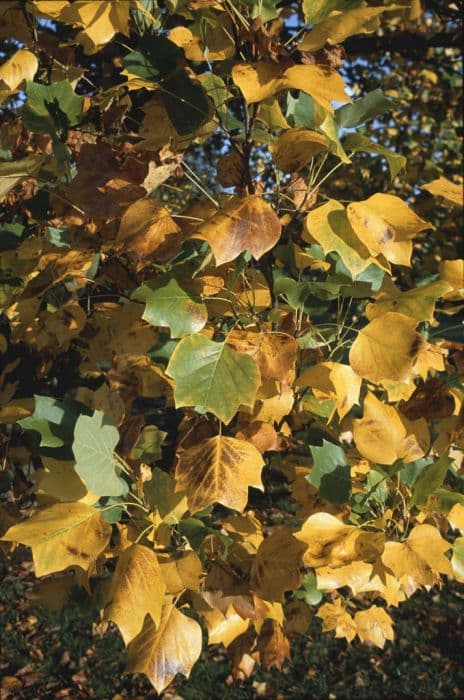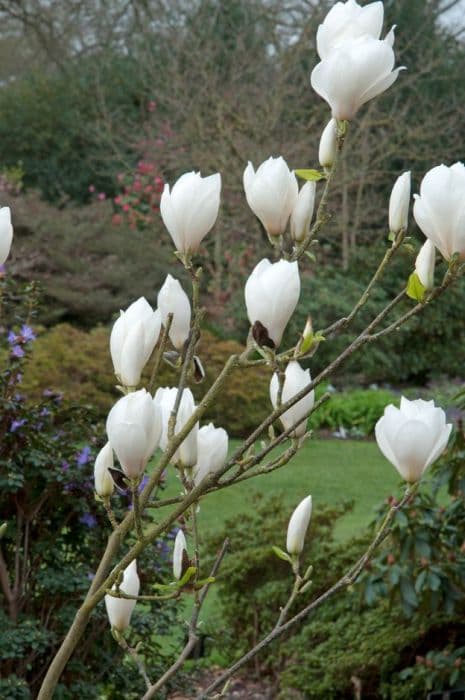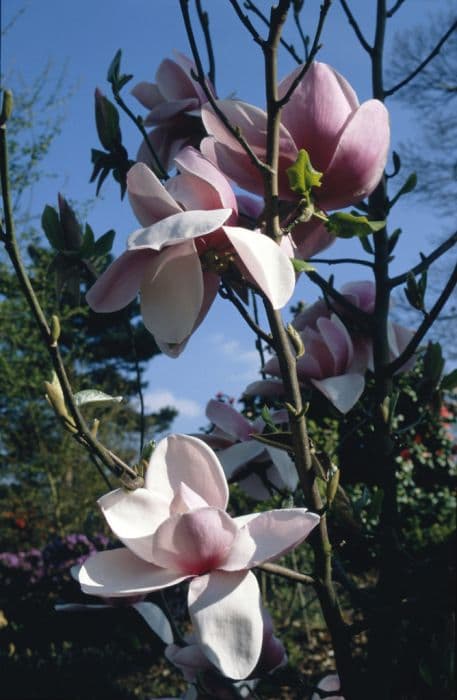Magnolia Magnolia sprengeri var. diva 'Burncoose'

ABOUT
The Magnolia sprengeri var. diva 'Burncoose', commonly known simply as Magnolia, is a striking plant renowned for its large, showy flowers. These blooms are cup-shaped when they open fully, and they are often a vibrant pink color. The petals are thick and waxy, and they can range from a pale pink at the edges to a deeper pink at the base, which sometimes appears almost magenta. The blooms emit a sweet, heady fragrance, especially on warm days, which can envelop the area around the plant. Outside of the blooming season, the magnolia presents a glossy green foliage. The leaves of this Magnolia are sizeable, oval-shaped, and have a leathery texture. During the fall, as the foliage matures, it might turn to hues of yellow or bronze before shedding. This plant is known for its attractive form, with a branching pattern that gives it a graceful, sometimes pyramidal, appearance. The bark of the Magnolia is smooth and gray, providing a pleasant contrast to the rich green of the leaves and the bright pink of the flowers. As the flowers fade, they give way to cone-like fruiting bodies. These fruiting bodies can hang on the branches and gradually change from green to a reddish-brown as they mature. The seeds inside are typically reddish-orange and may dangle from thin threads after the outer covering splits open. Overall, the Magnolia sprengeri var. diva 'Burncoose' adds aesthetic value to any landscape with its stunning floral display and year-round interest.
About this plant
 Names
NamesFamily
Magnoliaceae
Synonyms
Burncoose Magnolia
Common names
Magnolia sprengeri var. diva 'Burncoose'.
 Toxicity
ToxicityTo humans
The Magnolia is generally considered a non-toxic plant to humans. There is no widespread evidence to suggest that the Magnolia sprengeri 'Burncoose' or any parts of it are poisonous to people. Therefore, there should be no expected symptoms of poisoning. However, it is always prudent to avoid ingesting plants that are not commonly recognized as food items, as individual allergic reactions or sensitivities can still occur.
To pets
The Magnolia is also generally considered a non-toxic plant to pets. There is no significant evidence that Magnolia sprengeri 'Burncoose' or any parts of it are poisonous to pets such as dogs or cats. As with humans, there are typically no symptoms of poisoning linked to this plant. Despite this, pet owners should always monitor their animals to prevent the ingestion of non-food plants, as they can cause gastrointestinal upset or allergic reactions in some pets.
 Characteristics
CharacteristicsLife cycle
Perennials
Foliage type
Deciduous
Color of leaves
Green
Flower color
Pink
Height
15 feet 4.5 meters (4.5m)
Spread
10 feet 3 meters (3m)
Plant type
Tree
Hardiness zones
7
Native area
China
Benefits
 General Benefits
General Benefits- Aesthetic Appeal: Magnolia sprengeri 'Burncoose' has large, showy pink or crimson flowers that add significant ornamental value to gardens and landscapes.
- Fragrance: The flowers emit a sweet fragrance that can enhance the sensory experience of a garden.
- Pollinator Attraction: The blooms attract bees and other pollinators, contributing to the health of the local ecosystem.
- Shade Provider: As a tree, it can offer considerable shade in gardens and parks, creating cool areas during warm weather.
- Seasonal Interest: This magnolia has a distinctive flowering season in late winter to early spring, providing interest at a time when few other plants are in bloom.
- Wildlife Habitat: The tree can serve as a habitat and food source for a variety of birds and small mammals.
 Medical Properties
Medical PropertiesThis plant is not used for medical purposes.
 Air-purifying Qualities
Air-purifying QualitiesThis plant is not specifically known for air purifying qualities.
 Other Uses
Other Uses- Magnolia sprengeri var. diva 'Burncoose' can be utilized as a natural fabric dye, where the bark or petals may impart varying shades of color to textiles.
- The wood of the tree is sometimes used in fine woodworking or cabinet making, favored for its color and grain.
- Leaf extracts from magnolias have been used in fragrances and perfumery due to their sweet and pleasing scent.
- The petals are sometimes candied and used as a decorative and edible element in high-end culinary dishes.
- Dried magnolia flowers are incorporated into potpourri mixes, contributing to the mix's visual appeal and aroma.
- In traditional crafts, the plant's seed pods may be used to create natural jewelry or decorative items.
- Due to its large size and structural branches, the tree can serve as a natural trellis for climbing plants.
- Magnolia blossoms can be pressed and used in botanical art or herbarium collections for educational purposes.
- The leaves can be used to create a leaf mold compost, an excellent soil conditioner for gardens.
- Mature seeds can be used for bird food, as they attract a variety of species including finches and cardinals.
Interesting Facts
 Feng Shui
Feng ShuiThe Magnolia is not used in Feng Shui practice.
 Zodiac Sign Compitability
Zodiac Sign CompitabilityThe Magnolia is not used in astrology practice.
 Plant Symbolism
Plant Symbolism- Perseverance: The magnolia tree is known for its strength and the ability to withstand harsh conditions, making it a symbol of tenacity.
- Dignity: With its large, impressive blooms, the magnolia represents poise and self-respect.
- Feminine beauty: The magnolia's delicate and fragrant flowers are often associated with the purity and softness of feminine beauty.
- Nobility: The magnolia is considered a noble plant given its association with ancient southern plantations and the aristocratic bearing of its flowers.
- Love of nature: The magnolia's preference for natural, woodland environments makes it symbolic of a love for the natural world.
 Water
WaterThe Magnolia sprengeri 'Diva', commonly referred to as Pink Tulip Tree, prefers consistent moisture without being waterlogged. Water the plant deeply, allowing the soil to be moist but not soggy, approximately once a week during the growing season. The exact frequency depends on climate conditions, but ensure the top inch of soil dries out before watering again. A mature Pink Tulip Tree may require 10-15 gallons of water every two weeks, especially in dry spells. In winter, reduce watering to match the plant's dormant state, but don't allow the soil to become completely dry.
 Light
LightThe Pink Tulip Tree thrives in full sun to partial shade. For optimal growth and blooms, plant it in a location where it receives at least four to six hours of direct sunlight each day. An ideal spot would be one where the tree is shielded from the harsh afternoon sun, but still benefits from the bright morning light.
 Temperature
TemperatureThe Pink Tulip Tree can tolerate a range of temperatures but grows best in conditions between 60°F and 70°F. It can withstand minimum temperatures down to about -20°F once established, but young trees may require protection. The Pink Tulip Tree typically enjoys the climate in USDA hardiness zones 6 through 9.
 Pruning
PruningPruning of the Pink Tulip Tree is best done in late winter or early spring before the new growth starts. Pruning is primarily for shaping the tree and removing any damaged or diseased branches. It should be pruned sparingly, as it can reduce the following year's blooms. Remove only the necessary branches and maintain a natural form.
 Cleaning
CleaningAs needed
 Soil
SoilThe best soil mix for Magnolia sprengeri 'Diva' is one that is rich in organic matter, well-draining, and slightly acidic with a pH of 5.5 to 6.5. A combination of loamy soil, peat moss, and a small amount of sand or perlite will create an ideal environment for root growth.
 Repotting
RepottingMagnolia sprengeri 'Diva' should be repotted every 2-4 years or when it becomes root-bound. Younger plants may require more frequent repotting, while older, more established ones can be repotted less often.
 Humidity & Misting
Humidity & MistingMagnolia sprengeri 'Diva' prefers moderate to high humidity levels but is adaptable to average outdoor humidity conditions. It thrives when the air is not too dry; however, specific humidity levels are not strictly required for this hardy outdoor plant.
 Suitable locations
Suitable locationsIndoor
Provide bright indirect light, ample space, and monitor soil moisture.
Outdoor
Plant in moist, well-draining soil with dappled sunlight.
Hardiness zone
7-9 USDA
 Life cycle
Life cycle'Burncoose' Magnolia begins its life as a seed, which after germinating develops into a seedling with a basic root system and sprouting leaves. The seedling gradually matures into a young plant, increasing in size and developing characteristic large, glossy leaves, and strong woody stems. Over the years, as the plant reaches maturity, it begins to produce large, fragrant pink or reddish-purple flowers typically in early spring, before the leaves appear. After pollination by insects, the flowers give way to cone-like fruiting clusters, which release seeds when they mature in late summer to early fall. These seeds, once dispersed, have the potential to grow into new plants, thus repeating the cycle. Throughout its life, the 'Burncoose' Magnolia undergoes seasonal cycles of growth and dormancy, adapting to the environment to ensure survival and reproduction.
 Propogation
PropogationPropogation time
Spring to Summer
Magnolia sprengeri var. diva 'Burncoose', commonly known as Magnolia, is most frequently propagated through seed sowing. The ideal time to collect seeds is when the red seed cones start to open, typically in early fall. Cleaned seeds should be sown in a well-draining seed starting mix, barely covering the seed with the substrate. It's important to keep the soil consistently moist but not waterlogged during germination. Scarification of the seed coat by lightly sanding it can improve germination rates, but stratification or cold treatment overwinter is not typically necessary for this species. Once sprouted, seedlings need protection from extreme elements until they are strong enough to be planted out in their permanent location, usually after a season or two of growth.









